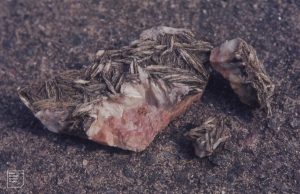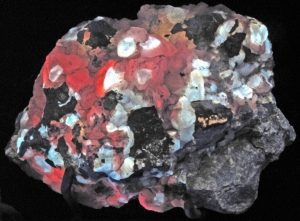Barium
What is Barium?
Barium is the 56th element on the periodic table and is a silvery alkaline earth metal. It is incredibly light for a metal and can be ground into a white powder. Barium can be found in fireworks, and is commonly used to help doctors read specific diagnostic X-rays more clearly.
Barium’s Place in the Periodic Table
Barium was named as such after it was purified from the mineral barite, or barium sulfate. While barium has a relatively low density, barium sulfate has a high density, and so the name barium comes from the Greek word barys which means heavy. Barium is also part of the alkaline earth metals, which all tend to be reactive, especially when forming basic oxides.
- Atomic number: 56
- Symbol: Ba
- Group: 2
- Period: 6
- Number of Protons: 56
- Number of Electrons: 56
- Number of Neutrons: 81
- Atomic Radius: 253 pm
- Atomic mass: 137.327
- Number of Isotopes: 7
Properties of Barium
Barium is a soft, silvery metal that is light to the touch. Barium is most commonly found in combination with sulfate or carbonate, but can also be found in hydroxide or nitrate forms as well. Barium corrodes easily because it can easily be oxidized. Like other metals, barium is a good conductor of heat and electricity. Barium is an alkaline earth metal, like magnesium and calcium, and they were given this classification in the 1860’s. They all tend to form basic oxides and are electropositive, meaning they tend to lose electrons to form positive ions. Barium itself, tends to be nontoxic in humans, but compounds such as barium carbonate can be toxic to humans.
Physical Properties
As mentioned previously, barium has a relatively low density compared to other metals which makes it feel really light. For comparison, barium’s density is 3.51 g/cm3, whereas gold’s is over 5 times that at 19.3 g/cm3.
- Melting Point: 1000 K (727°C)
- Boiling Point: 2143 K (1870°C)
- Density: 3.51 g/cm3
- Phase at Room Temperature: solid
Chemical Properties
Barium can be readily attacked by most acids, except for sulfuric acid, which will form a coating of barium sulfate on the surface of the metal and halt the reaction. Barium can also form strongly basic oxides such as barium hydroxide (BaOH)2. Barium has a relatively low electronegativity at 0.89, especially considering the least electronegative elements are around 0.7. Despite this low electronegativity, barium is never found in its pure form in nature because it is so reactive. This is in part because oxygen is so reactive, and bonds to barium in nature, but also because barium can be found in its ionic form, which makes bonding simpler.
- Oxidation states: +1, +2
- Specific Heat: 205 J/(kg K)
- Electronegativity: 0.89
- Heat of Fusion: 8 kJ/mol
- Heat of Vaporization: 140 kJ/mol
- Electron Configuration: [Xe]6s2
Isotopes
Barium has 7 naturally occurring isotopes, with 6 of them being stable (130Ba, 134Ba, 135Ba, 136Ba, 137Ba, 138Ba) and one being unstable, but with a very long half-life (132Ba). It was only recently that scientists discovered that 132Ba isn’t stable, but it only makes up 0.101% of natural barium abundance. The most abundant isotope is 138Ba at 71.698%, followed by 137Ba at 11.232%, 136Ba at 7.854%, and 135Ba at 6.592%. The last two have very low abundance with 134Ba at 2.417% and 130Ba at 0.106%. Several of the isotopes are used in production of radioisotopes which are in turn used for medical tests and treatments.
Alloys and Allotropes
Barium can form many different alloys, and is most commonly used in either alloy or compound form. Pure barium, or barium-aluminum alloys can be used to clear oxygen from vacuum tubes and barium alloy with nickel is commonly used in spark plugs. Barium alloyed with either calcium, manganese, silicon, or aluminum can be used as high-grade steel deoxidizers.
Compounds of Barium
Many of the notable compounds of barium have been mentioned, simply because barium is rarely found in nature. The mineral barite is by far the most common, but barium chloride and barium hydroxide are more likely to show up in your chemistry homework. Barium chloride is one of the few water-soluble salts of barium, whereas barium hydroxide is used in analytical chemistry for titration of weak acids, specifically organic acids. Titration is a chemical technique used to determine the concentration of a solution that commonly utilizes acid/base reactions.

“Cockscomb Barytes – Barium sulphate on iron stained calcite, near Risca Ochrwyth, 1969” by Dr Mary Gillham Archive Project is licensed under CC BY 2.0
Interesting Facts about Barium
- Barium is present in foods such as carrots, onions, lettuce, beans and cereal grains.
- Barite minerals were used in some ancient forms of witchcraft because the stones would glow after exposure to light.
- The one unstable, naturally occurring isotope of barium (130Ba) has a half-life longer than the age of the Universe.
- The barium-containing mineral benitoite has a fluorescent blue color and is the official gemstone of California.
- Barium sulfate will emit a phosphorescent red glow when it is heated and combusted.
- These glowing barium sulfate stones were first discovered and made in the 1500s in Bologna, Italy and were called the Bologna stones.
- Barium is one of 6 elements discovered by Sir Humphrey Davy.
- 90% of barium mined in the US is used by the petroleum industry.
- Barium has 33 known radioisotopes that are not naturally occurring.
- Barium powder can ignite spontaneously in air.

“Barite fluorescing (Cedar Mountain Formation, Lower Cretaceous; Uintah County, Utah, USA) 3” by James St. John is licensed under CC BY 2.0
Occurrence and Abundance of Barium
Barium is only found in nature in compound form. It is commonly mined as the mineral barite, or barium sulfate, and the largest producers are China, India, and Morocco. Within the US, Nevada and Georgia are the largest producers of barium. Barium can also be mined as witherite, or barium carbonate, but this is less common. Barium makes up about 0.034% of the Earth’s crust and even less of the oceans at only 3×10-6%. Even though a couple of compounds of barium are toxic, it has 0.00003% abundance in humans.
Uses of Barium
Most Notable Uses in General
Barium has only a few common uses, and it is usually in either compound or alloy form. For example, barium carbonate can be combined with fireworks to give the pyrotechnics a green color. It can also be found in a product called lithopone, which is a brightening pigment in printer paper and paint. Additionally, it can be added to alloys used in spark plugs, which makes the spark plugs more efficient.
Most Notable Uses in Science
Pure barium is good at making sure vacuums are completely clear of air. It does this by very easily forming compounds with any oxygen that could be present. Barium sulfate is also a very common contrast agent for X-rays, meaning that when it’s in the body during an X-ray, it stands out as bright white on the developed film. Barium sulfate is commonly used to coat the inside of the esophagus, stomach or intestines so they can be seen more clearly on X-rays or CT scans.
Discovery of Barium
In the late 18th century, barium carbonate was discovered by William Withering, but it wasn’t until 1808 that barium was purified. The purification happened at the Royal Institute of London when Sir Humphrey Davy used electrolysis to separate barium from molten barium salts.
Barium in the Future
The medical community has actually seen a recent slow drop in the number of tests done with barium sulfate as a contrast agent. Since it is slowly becoming a less prevalent technique, it isn’t covered in medical residency as often. Because of the limited other uses of barium, and a dwindling presence in the medical community, there is little current research being done for future uses or applications or barium.